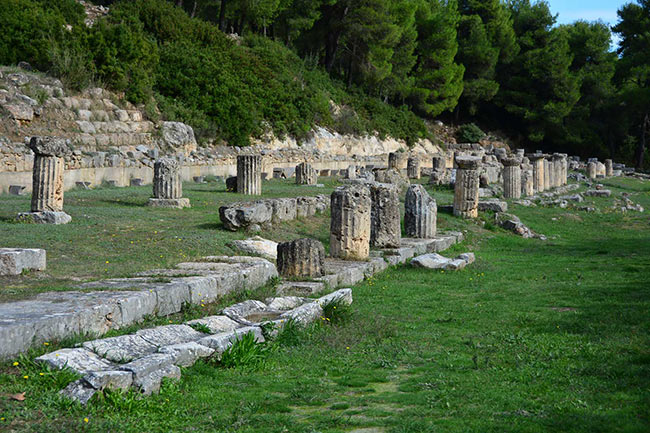Amphiareion of Oropos
The ancient theater of the Amphiareion at Oropos and its marble throne represent a unique chapter in the religious, social, and healing traditions of ancient Greece. It was not merely a place for theatrical or religious performances but also served as an important center for healing, prophecy, and the worship of the god. Let us explore this in more detail:
Introduction to the Amphiareion Sanctuary
The sanctuary was named after the seer-hero Amphiaraos.
According to Greek mythology, Amphiaraos was a famous prophet and warrior who took part in the campaign of the Seven Against Thebes. After his death, he was deified, and worship of him began at Oropos.
Pilgrims came here seeking divine dreams (incubation) for prophecy or healing. Patients would sleep in the temple, and their dreams were interpreted by the priests.
Architecture and Main Buildings
The sanctuary contained several important structures:
Stoa
Built around the mid-4th century BCE.
Served mainly as a dormitory for patients who stayed while hoping for miraculous healing.
Theatre
Constructed in the 2nd century BCE.
Its original seating was made of wood, placed on stone supports.
Though relatively small, it hosted religious plays, competitions, and rituals.
Temple and Other Facilities
A temple dedicated to Amphiaraos.
A sacred spring and water sources, used in healing practices.
Special Features of the Theatre
Around the orchestra, archaeologists discovered five prohedria (front-row seats).
These were smooth, marble thrones reserved for priests and honored guests—distinct from the wooden benches of ordinary spectators.
The marble seats, over 2,000 years old and still preserved today, demonstrate that the theatre was not just for performances but also for religious ceremonies and sacred rites.
Religious and Healing Practices
Visitors came here for cures, much like at the famous Asklepieion of Epidaurus.
Patients received divine guidance through dreams.
Healing may have involved ritual bathing in sacred water, dietary practices, worship, and even the therapeutic effect of drama and music.
Cultural Significance
The Amphiareion sanctuary and theatre illustrate how religion, drama, and healing were deeply interconnected in Greek society.
The marble prohedria (thrones) symbolized religious authority and social hierarchy.
Today, Oropos remains a place of fascination for tourists and historians, preserving a unique combination of ancient Greek healing practices, religious worship, dramatic culture, and architecture.
The ancient theatre of the Amphiareion at Oropos, with its marble thrones, shows how worship, healing, drama, and social honor were united within one sanctuary. It was not merely a place of entertainment but also a center of prophecy, divine healing, and sacred ritual dedicated to the god Amphiaraos. The preserved prohedria reveal the importance of priests and elite guests, while the site as a whole provides key insights into the religious and social life of ancient Greece.
Source
Travlos, J. Pictorial Dictionary of Ancient Athens. London: Thames and Hudson, 1971.
Petrakos, V. Oropos and the Amphiareion. Athens: Archaeological Society, 1997.
Camp, J. M. The Archaeology of Athens. Yale University Press, 2001.
Hellenic Ministry of Culture and Sports – Amphiareion of Oropos (official site).

